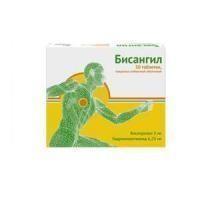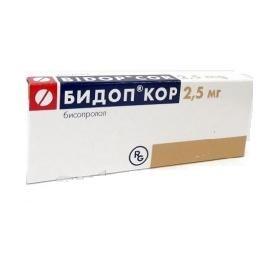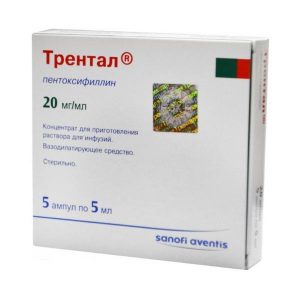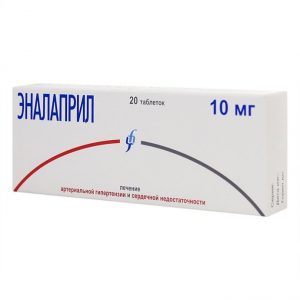Description
Release form
Tablets.
Packing
Per pack 30 pcs.
Pharmacological action
Bisoprolol is a selective beta1-blocker without internal sympathomimetic activity. It has antihypertensive, antiarrhythmic and antianginal effects. Blocking 1-adrenoreceptors of the heart in low doses, it reduces the formation of cAMP stimulated by catecholamines from ATP, reduces the intracellular current of calcium ions, has a negative chrono-, dromo-, batmo- and inotropic effect (reduces heart rate, inhibits cardiac conduction, reduces myocardial excitability and contractility ) With increasing doses, it blocks 2-adrenergic receptors. OPSS at the beginning of the use of beta-blockers, in the first 24 hours it increases (as a result of a reciprocal increase in the activity of -adrenoreceptors and the elimination of stimulation of 2 -adrenoreceptors), after 1-3 days it returns to the original, and decreases with prolonged administration.
The antihypertensive effect is associated with a decrease in minute blood volume, suppression of sympathetic stimulation of peripheral blood vessels, a decrease in the activity of the renin-angiotensin-aldosterone system by inhibiting the β-adrenergic receptors of the juxtaglomerular apparatus of the kidneys (which leads to a decrease in renin secretion), and restoration of the sensitivity of aorta baroretors their activity in response to a decrease in blood pressure) and effects on the central nervous system. With arterial hypertension, the effect develops after 2-5 days, a stable effect – after 1-2 months. therapy.
hydrochlorothiazide is a thiazide diuretic, violates the reabsorption of sodium, chlorine, potassium, magnesium ions in the distal nephron, delays the excretion of calcium, uric acid. An increase in renal excretion of these ions is accompanied by an increase in the amount of urine (due to the osmotic binding of water). Hydrochlorothiazide reduces blood plasma volume, increases plasma renin activity and aldosterone secretion. When taken in high doses, hydrochlorothiazide increases the excretion of bicarbonates, while long-term use reduces the excretion of calcium.
The antihypertensive effect develops due to a decrease in bcc, changes in the reactivity of the vascular wall, decrease in the pressor effect of vasoconstrictor amines (adrenaline, norepinephrine) and an increase in the depressant effect on the ganglia. It does not affect normal blood pressure. Diuretic effect is observed after 1-2 hours, reaches a maximum after 4 hours and lasts 6-12 hours. The antihypertensive effect occurs after 3-4 days, but 3-4 weeks are needed to achieve the optimal therapeutic effect.
Indications
– mild to moderate arterial hypertension.
Contraindications
– hypersensitivity to bisoprolol and other components of the
drug – hypersensitivity to hydrochlorothiazide and other sulfonamide derivatives
– severe forms of bronchial asthma and chronic obstructive pulmonary disease
– acute cardiac insufficiency or congestive heart failure of
therapy – cardiogenic shock
– sinus node weakness syndrome (including sinoatrial block)
– AV block II and III degree without artificial pacemaker
– severe bradycardia (heart rate less than 50 beats / min. )
– pheochromocytoma (without the simultaneous use of alpha-adrenergic blocking agents)
– difficult to control diabetes mellitus
– late stages of peripheral circulatory disturbance (including Raynaud’s syndrome)
– severe arterial hypotension (systolic blood pressure less than 100 mm rt.p.) – refractory hypokalemia, hyponatremia, hypercalcemia
– metabolic acidosis
– acute renal failure
– chronic renal failure (creatinine clearance (CC) less than 30 ml / min.), Anuria
– severe impairment of liver function audio (including coma and precoma)
– simultaneous application floctafenine, sultloprid
– concomitant use of monoamine oxidase inhibitors (MAOs), with the exception of MAO inhibitors of type B)
– age under 18 years (efficacy and safety have not been established)
– lactose intolerance, lactase deficiency or glucose-galactose malabsorption
– pregnancy
Caution should be used in heart failure, AV block I degree, Prinzmetal angina, peripheral circulation disorders, coronary heart disease, liver failure, renal failure (CC more than 30 ml / min.) hyperthyroidism, pheochromocytoma (during treatment with alpha-blockers) water-electrolyte disorders (hyponatremia, hypokalemia, hypercalcemia) depression (including a history), myasthenia gravis, gout, psoriasis, as well as in elderly patients, hyperuricemia, diabetes mellitus with significant fluctuations in the concentration of glucose in the blood, a strict diet, hypovolemia, bronchial asthma, bronchospasm (history), desensitizing therapy.
Use during pregnancy and lactation
The use of Bisangil is contraindicated in pregnancy.
It is currently unknown whether bisoprolol is excreted in breast milk. Diuretics from the thiazide group are excreted in breast milk and therefore breast-feeding during treatment with Bisangil is not recommended. If the use of the drug is necessary during lactation, breastfeeding must be canceled.
Special instructions
During therapy with Bisangil, heart rate and blood pressure monitoring is necessary (at the beginning of treatment daily, then 1 time every 3-4 months), blood glucose concentration in patients with diabetes mellitus (1 time every 4-5 months) . In elderly patients, it is recommended to monitor renal function (1 time in 4-5 months). It is necessary to teach the patient the method of calculating heart rate. During the period of therapy with Bisangil, it is also necessary to monitor the indicators of the acid-base state and the content of electrolytes (potassium, sodium, calcium). More frequent monitoring of potassium in high-risk patients is needed. In patients with impaired peripheral circulation, caution should be exercised when prescribing Bisangil.
With thyrotoxicosis, the drug Bisangil (due to the content of bisoprolol in it) can mask the clinical signs of the disease (for example, tachycardia).
Patients with pheochromocytoma should not be prescribed Bisangil unless treatment with alpha-blockers is prescribed. In this case, it is necessary to control blood pressure.
In patients with mild asthma or chronic obstructive pulmonary disease, treatment is started with a minimum dose.
It is recommended to discontinue therapy with Bisangil in case of development of depression caused by taking beta-blocker (due to the content of bisoprolol in it). In elderly patients, treatment with Bisangil should begin with a dosage form containing a low dose of bisoprolol (2.5 mg). In this case, regular monitoring of the condition of patients is necessary.
Composition
1 tab.
bisoprolol fumarate 5 mg
hydrochlorothiazide 6.25 mg
Excipients: lactose monohydrate – 130.25 mg, microcrystalline cellulose – 36 mg, croscarmellose sodium – 4 mg, corn starch – 9.5 mg, povidone – 7 mg, magnesium stearate – 2 mg.
Dosage and administration of
Bisangil is recommended to be taken in the morning (during meals). Tablets should be swallowed whole, without chewing, washed down with a small amount of liquid, 1 time / day.
The dose of the drug should be selected individually.
The initial dose of Bisangil is 1 tablet 2.5 mg / 6.5 mg (bisoprolol 2.5 mg / hydrochlorothiazide 6.25 mg) 1 time / day.
If the antihypertensive effect is insufficient, the dose is increased (after 2 weeks) – 1 tablet 5 mg / 6.25 mg (bisoprolol 5 mg / hydrochlorothiazide 6.25 mg) 1 time / day.
Patients with impaired liver function, as well as elderly patients, correction of the dosage regimen is not required.
In patients with impaired renal function (CC more than 30 ml / min), the maximum daily dose of bisoprolol should not exceed 10 mg.
Side effects
The frequency of adverse reactions below was determined according to the following (World Health Organization classification): very often – at least 10% often – at least 1%, but less than 10% infrequently – at least 0.1%), but less 1% rarely – not less than 0.01%, but less than 0.1% very rarely – less than 0.01%>, including individual messages.
From the side of the heart and blood vessels: very often – decrease in heart rate (bradycardia, especially in patients with chronic heart failure), palpitations, often – a marked decrease in blood pressure (especially in patients with chronic heart failure), manifestation of angiospasm (increased peripheral circulation disorders, sensation cold in the extremities (paresthesia) infrequently – violation of AV conduction (up to the development of complete transverse blockade and cardiac arrest), arrhythmias, orthostatic hypotension, aggravation of chronic oh heart failure with the development of peripheral edema (swelling of ankles, feet dyspnea), chest pain
From the nervous system:. often – dizziness, headache, asthenia, fatigue, sleep disturbances, depression, concern rarely – confusion or short-term memory loss, nightmares, hallucinations, myasthenia gravis, tremors, muscle cramps. Typically, these phenomena are mild and go away, usually within 1-2 weeks after the start of treatment.
On the part of the sensory organs: rarely – visual impairment, decreased lacrimation (should be taken into account when wearing contact lenses), tinnitus, hearing loss, earache very rarely – dry and sore eyes, conjunctivitis, taste disturbances.
From the respiratory system: infrequently – bronchospasm in patients with bronchial asthma or obstructive respiratory diseases rarely – allergic rhinitis nasal congestion.
Co side of the digestive system: often – nausea, vomiting, diarrhea, constipation, dry oral mucosa, abdominal pain rarely – hepatitis, increased activity of liver enzymes (ALT, AST), increased bilirubin concentration, taste change.
From the side of the musculoskeletal system: infrequently – arthralgia, back pain.
From the genitourinary system: very rarely – impaired potency, weakening libido.
Laboratory indicators: rarely – increased concentration of triglycerides in the blood in some cases – thrombocytopenia, agranulocytosis, leukopenia.
Allergic reactions: rarely – skin itching, rash, urticaria.
From the skin: rarely – increased sweating, skin hyperemia, exanthema, psoriasis-like skin reactions very rarely – alopecia, beta-blockers can exacerbate the course of psoriasis.
Other: withdrawal syndrome (increased angina attacks, increased blood pressure).
Hydrochlorothiazide
Disruption of water-electrolyte balance: hypokalemia, hypomagnesemia, hypercalcemia and hypochloremic alkalosis: dry oral mucosa, thirst, irregular heart rhythm, changes in mood or psyche, muscle cramps and pains, nausea, vomiting, unusual tiredness or weakness. Hypochloremic alkalosis can cause hepatic encephalopathy or hepatic coma. Hyponatremia: confusion, convulsions, lethargy, slowing of the thinking process, increased fatigue, irritability, muscle cramps.
Metabolic disorders: hyperglycemia, glucosuria, hyperuricemia with the development of an attack of gout.
Thiazide treatment may impair glucose tolerance, and latent diabetes mellitus may manifest. When using high doses, serum lipid concentrations may increase.
From the digestive system: cholecystitis or pancreatitis, cholestatic jaundice, diarrhea, sialadenitis, constipation, anorexia.
From the side of the heart and blood vessels: arrhythmias, orthostatic hypotension, vasculitis.
From the nervous system: dizziness, temporarily blurry vision, headache, paresthesia.
From the hemopoietic organs: very rarely – leukopenia, agranulocytosis, thrombocytopenia, hemolytic anemia, aplastic anemia.
Allergic reactions: urticaria, purpura, necrotic vasculitis, Stevens-Johnson syndrome, respiratory distress syndrome (including pneumonitis and non-cardiogenic pulmonary edema), photosensitivity, anaphylactic reactions up to shock.
Other: decreased potency, impaired renal function, interstitial nephritis.
Overdose
Bisoprolol
The most common symptoms of beta-blocker overdose are: severe BP, bradycardia, AV blockade, bronchospasm, acute heart failure and hypoglycemia.
Hydrochlorothiazide
Clinical manifestations of acute or chronic overdose with hydrochlorothiazide result in significant loss of fluid or electrolytes.
The most common symptoms of hydrochlorothiazide overdose: dizziness, nausea, drowsiness, hypovolemia, severe BP, hypokalemia.
Treatment: in the event of an overdose, first of all, it is necessary to discontinue the drug, wash the stomach, appoint adsorbing agents and start conducting supportive symptomatic therapy.
In severe bradycardia: at / in the introduction of atropine. Occasional staging of an artificial rhythm driver may be required. With a marked decrease in blood pressure: in / in the introduction of plasma-replacement solutions. With AV blockade (II and III degree): patients should be under constant observation, epinephrine prescription possible, if necessary – setting an artificial rhythm driver. At an exacerbation of a course of chronic heart failure: in / in introduction of diuretics, preparations with positive inotropic effect, and also vasodilators. In bronchospasm: administration of bronchodilators, beta-sympathomimetics and / or aminophylline. In hypoglycemia: in / in the appointment of a solution of dextrose (glucose).
Storage Conditions
The product should be stored in a dry, dark place out of the reach of children at a temperature not exceeding 25 ° C.
Shelf life
3 years.
Deystvuyushtee substance
bisoprolol, hydrochlorothiazide
Pharmacy terms
Prescription
dosage form
tablets
Prescribing
Prescribing as a doctor
Ozon, Russia




